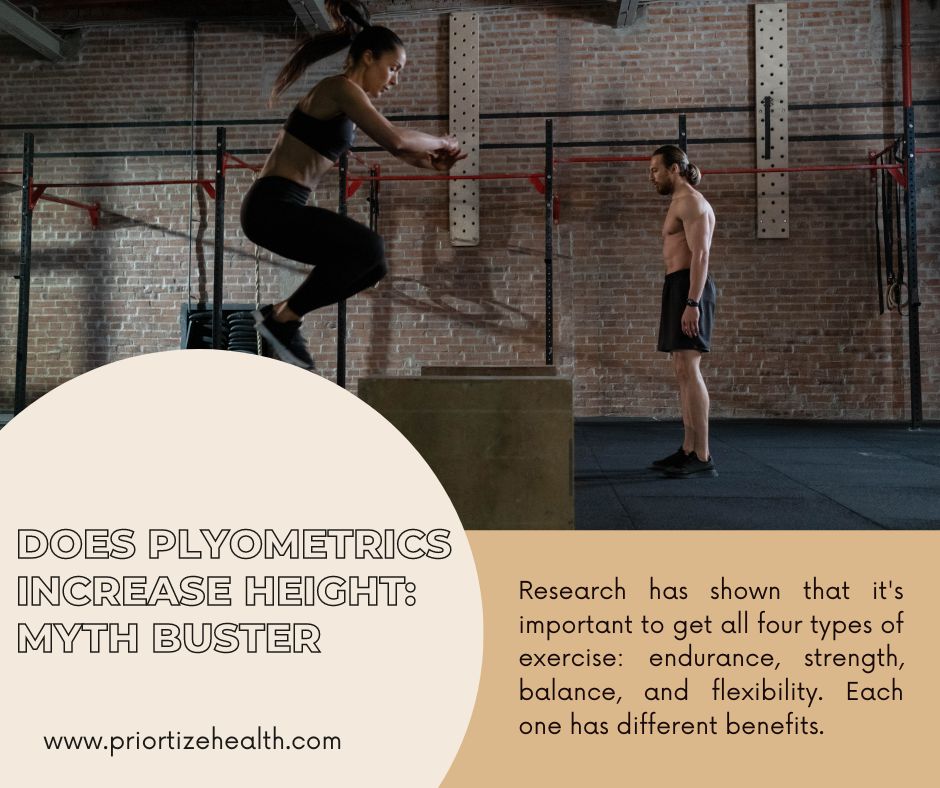
Does Plyometrics Increase Height: Myth buster
In the quest for physical enhancement, individuals often explore various methodologies to achieve their desired goals. When it comes to height, the internet has many claims and counterclaims. There are techniques that can add inches to one’s stature. Among these, plyometrics is a form of exercise. It helps to improve power and agility. This exercise has garnered attention for its purported ability to increase height. But, does it work? Let’s delve into the science behind plyometrics and its impact on height.
Understanding Plyometrics
Plyometrics is also popular as “plyos” or “jump training”. It is a form of exercise that focuses on explosive movements. This exercise also helps to enhance muscular power, speed, and agility. The concept behind plyometrics lies in usage of the stretch-shortening cycle (SSC). It is a biomechanical phenomenon that occurs within muscles and tendons during certain movements.
1. Stretch-Shortening Cycle (SSC)
The stretch-shortening cycle involves three phases:
- Eccentric Phase (Stretch): During this phase, the muscle lengthens under tension, in response to an external force. For example, when performing a jump, the muscles of the lower body lengthen as the body descends toward the ground. These muscles are the quadriceps and glutes.
- Amortization Phase (Transition): This is the brief period between the eccentric and concentric. Here the muscle transitions from lengthening to shortening. The duration of this phase is critical. It is because a shorter amortization phase leads to more powerful contractions.
- Concentric Phase (Shortening): In this phase, the muscle contracts, utilizing the elastic energy stored during the eccentric phase. This helps to produce a rapid and powerful movement. Using the example of a jump, the muscles of the lower body contract to propel the body upward.
2. Exercises and Techniques
Plyometric exercises involve rapid and explosive movements that engage in different muscle groups. Some common plyometric exercises include:
- Jump Squats: Starting from a squatting position, explode upward into a jump. Come back into the squat position.
- Box Jumps: Jump onto a sturdy box or platform from a standing position, then step or jump back down and repeat.
- Depth Jumps: Step off a raised platform. On immediately landing, jump upward as explosively as possible.
- Bounding: Perform consecutive long jumps or strides. Focus on covering as much distance as possible with each leap.
3. Benefits of Plyometrics
Plyometrics offer several benefits, including:
- Improved Power and Explosiveness: Train the body to generate maximal force in minimal time. Plyometrics enhance explosive power and speed. It is crucial for activities like sprinting, jumping, and sports requiring quick bursts of movement.
- Enhanced Neuromuscular Coordination: Plyometric exercises improve coordination between the nervous system and muscles. This leads to more efficient movement patterns and better athletic performance.
- Increased Bone Density: The high-impact nature of plyometrics stimulates bone growth. It also increases bone density. This exercise reduces the risk of osteoporosis and bone-related injuries.
- Calorie Burn and Weight Management: Plyometric workouts elevate heart rate and metabolism. It facilitates calorie burn and aids in weight management and fat loss.
4. Safety Considerations
Plyometrics offers many benefits. But it’s essential to approach them with caution to prevent injury. Beginners should start with low-intensity plyometric exercises. They should progress to more advanced movements. Do it in a gradual manner. Ensure proper warm-up, technique, and adequate rest between sessions. It is crucial for injury prevention.
Plyometrics is a dynamic training method that harnesses the body’s natural biomechanics. This helps to improve power, speed, and agility. We should understand the science behind plyometrics and implementing appropriate exercises. This can unlock the athletic potential and help to reap the benefits of this effective training modality.
The Relationship Between Exercise and Height
Height is a fundamental aspect of human physiology. It depends on various factors like genes, environment, and lifestyle. Genetics play a predominant role in determining an individual’s potential height. But, lifestyle factors such as nutrition, exercise, and health can also impact growth and development. It is particularly during childhood and adolescence.
1. Genetics and Height Determination
Genetics is the primary determinant of an individual’s height potential. Human height is a complex trait. It depends on different genes, with contributions from both parents. These genes regulate processes such as bone growth, skeletal development, and hormonal signalling. They dictate an individual’s growth trajectory.
2. Growth Factors During Development
During childhood and adolescence, the body undergoes rapid growth and development, driven by hormonal signals and growth factors. The pituitary gland produces the growth hormone (GH). It plays a crucial role in stimulating growth and influencing bone lengthening during puberty. Insulin-like growth factor 1 (IGF-1), produced in response to GH, further supports tissue growth and development.
3. Nutrition and Height
Nutrition plays a vital role in supporting optimal growth and development. Adequate intake of essential nutrients, including proteins, vitamins, minerals, and calories. They provide the building blocks necessary for bone growth, muscle development, and health. Malnutrition or deficiencies in key nutrients during critical periods of growth can impede height potential. This can lead to stunted growth.
4. Exercise and Height
Exercise is essential for health and fitness. But there is a limited impact on height, particularly after the growth plates in the bones fuse, and by the end of puberty. Regular physical activity during childhood and adolescence can support healthy growth and development by:
- Stimulating Growth Hormone Production: Certain types of exercise, such as high-intensity interval training (HIIT) and resistance training, can increase growth hormone secretion. It can support growth and development during puberty.
- Promoting Bone Health: Weight-bearing exercises stimulate bone growth and increase bone density. They include running, jumping, and resistance training. It also reduces the risk of fractures and osteoporosis later in life.
- Supporting Our Health: Regular exercise promotes cardiovascular health, strengthens muscles, and improves posture and alignment. These factors contribute to an individual appearing taller and maintaining optimal skeletal health.
5. Exercise After Growth Plate Closure
Once an individual reaches skeletal maturity, further vertical growth reduces as. It is due to the growth plates in the long bones fuse that signal the end of the growth phase. Exercise can still offer many health benefits. It includes improved strength, endurance, and well-being. They do not lead to an increase in height beyond this point.
Debunking the Myth
Height has long been a subject of fascination and desire for many individuals. This leads to the proliferation of myths and misconceptions surrounding methods to increase stature. One such myth revolves around the belief that plyometric exercises, can somehow extend an individual’s height. It is with their emphasis on explosive movements and power development. But there were closer examination of the scientific principles governing human growth and the mechanics of plyometric training. The result discovered was that we still have to find evidence for this belief.
1. Skeletal Maturity and Height Potential
We can determine human height by genetics and growth factors. They influence bone growth and development during childhood and adolescence. The growth plates are crucial sites where longitudinal bone growth occurs. These growth plates are also known as epiphyseal plates. They are present at the ends of long bones. As individuals progress through puberty, hormonal signals and genetic factors regulate the closure of these growth plates. This marks end of the growth phase. The growth plates fuse may be by the late teens or early twenties. Then the further vertical growth ceases, and an individual reaches their maximum height potential. This process is popular by the term skeletal maturity. It limits any further increase in height, regardless of external interventions such as exercise.
2. Mechanisms of Plyometric Training
There are rapid, explosive movements in plyometric exercises. They utilize the stretch-shortening cycle (SSC) to generate maximal force in minimal time. During plyometric movements, muscles undergo rapid lengthening (eccentric phase). It is followed by an immediate shortening (concentric phase). This in turn elicits a powerful contraction. These movements can be in form of jump squats or box jumps. Plyometrics are effective for improving muscular power, speed, and agility. They target the muscular and neuromuscular systems rather than influencing bone growth or elongation.
3. Lack of Evidence Supporting Height Increase
Despite anecdotal claims and popular misconceptions, there is a lack of scientific evidence. There is less support for the notion that plyometric exercises can increase height beyond an individual’s predetermined potential on basis of genetics. Height is a multifactorial trait influenced by genetic, hormonal, and environmental factors. Exercise plays a minimal role in altering stature once you reach skeletal maturity. Various studies examining the effects of exercise interventions, including plyometrics, on height have failed to proof any significant increase in height beyond the expectation based on natural growth patterns.
4. Indirect Effects on Posture and Alignment
Plyometric training may not increase height. But it can influence an individual’s appearance and posture. By strengthening core muscles, improving muscular balance, and enhancing body awareness, plyometric exercises can promote better posture and alignment. It reduces the appearance of slouching and maximizes one’s natural height potential. Maintaining a healthy weight and adopting proper ergonomics in daily activities can further support optimal spinal alignment and height preservation.
Separating Fact from Fiction
The belief that plyometric exercises can increase height is a myth that lacks scientific substantiation. We can determine height by genetic factors and growth patterns established during childhood and adolescence. Exercise plays a minimal role in altering stature once a person reaches skeletal maturity. Plyometric training offers many benefits for muscular power, speed, and athletic performance. But, individuals should not expect these exercises to have a significant impact on their height. Focus on health, proper nutrition, and maintain a good posture This can support optimal physical development and well-being, regardless of one’s height.
Enhancing Posture and Alignment
Posture and alignment play crucial roles in health, well-being, and physical appearance. Poor posture can lead to musculoskeletal imbalances, discomfort, and increased risk of injury. Plyometric training, with its emphasis on explosive movements and dynamic exercises, can contribute to improving posture. It also helps in alignment through various mechanisms.
1. Strengthening Core Muscles
Plyometric exercises engage various muscle groups. It includes those in the core region (abdominals, obliques, lower back), to stabilize the body during explosive movements. A strong and stable core is essential for maintaining proper posture and alignment. It supports the spine and pelvis, preventing excessive curvature and promoting a neutral spinal position. By targeting the core muscles through exercise, we can develop core strength and stability. This leads to improved posture. These exercises can be in the form of jump squats, plank jumps, and medicine ball throws.
2. Improving Muscular Balance and Symmetry
Muscular imbalances can contribute to poor posture and alignment. It can be where certain muscles are stronger or tighter than others. Plyometric exercises involve dynamic movements and multi-joint actions. It helps to address these imbalances by promoting symmetrical muscle development and coordination. Engage both the agonist and antagonist muscle groups in explosive contractions. Plyometric training encourages balanced muscle activation and function. It reduces the risk of postural deviations and compensatory movements.
3. Enhancing Body Awareness and Proprioception
There should be precise coordination, timing, and spatial awareness in plyometric exercises. It helps to execute explosive movements in effective manner. As individuals perform plyometric drills, they become more attuned to their body’s position. It improves movement patterns, and alignment. This heightened body awareness, known as proprioception, enables individuals to maintain proper posture and alignment. It is during both plyometric exercises and daily activities. By reinforcing correct movement patterns and alignment cues, plyometric training enhances proprioceptive feedback. It also promotes better posture over time.
4. Addressing Weaknesses and Dysfunctions
Certain individuals may have specific weaknesses or dysfunctions. They can contribute to poor posture or alignment. Plyometric training can help identify and address these issues. It targets key areas of weakness and instability. For example, individuals with weak gluteal muscles may experience pelvic tilt and lower back pain. Plyometric exercises that emphasize hip extension can strengthen the glutes and improve pelvic alignment. It addresses underlying issues contributing to poor posture. These exercises can be in form of jumping lunges or single-leg box jumps.
5. Promoting Spinal Alignment and Erect Posture
We can characterize proper spinal alignment by a neutral curvature of the spine. It is essential for maintaining an erect posture and minimizing stress on the spine and surrounding structures. Plyometric exercises that engage the posterior chain, including the back extensors and spinal erectors. It can help promote spinal alignment and erect posture by strengthening these muscles. Additionally, plyometric drills that involve vertical jumping movements can encourage upward spinal elongation and extension. It counteracts the effects of gravity and postural slumping.
Benefits Beyond Height Increase
Plyometric training, renowned for its explosive movements and dynamic exercises, offers a multitude of benefits. that extend far beyond any potential increase in height. From enhancing athletic performance to promoting health and well-being, plyometrics are a versatile and effective training modality. They have many advantages.
1. Improved Athletic Performance
Plyometrics are popular for their ability to enhance athletic performance across various sports and activities. It targets on fast-twitch muscle fibers and improves neuromuscular coordination. Plyometric training helps athletes develop explosive power, agility, and speed. This translates into improved performance in activities such as sprinting, jumping, cutting. It focuses on change of direction maneuvers. This is essential for success in sports like basketball, soccer, volleyball, and track and field.
2. Enhanced Muscular Power and Strength
The explosive nature of plyometric exercises stimulates rapid muscle contractions. This results in increased muscular power and strength. By incorporating movements such as jump squats, plyometric push-ups, and bounding drills, individuals can effectively overload their muscles. It promotes hypertrophy, leading to gains in strength and power. This enhanced muscular strength improves athletic performance. It also contributes to functional capacity and daily activities requiring strength and power.
3. Greater Bone Density and Strength
Plyometric exercises involve high-impact movements like jumping and landing. It provides mechanical loading to the skeletal system, stimulating bone growth and increasing bone density. This helps to strengthen bones, reduce the risk of osteoporosis, and improve bone health. Regular plyometric training can be beneficial for individuals at risk of bone-related conditions. It promotes bone remodeling and adaptation.
4. Enhanced Cardiovascular Fitness
Plyometric workouts are demanding and often involve high-intensity intervals. This leads to elevated heart rate and increased cardiovascular demands. As a result, plyometric training can improve cardiovascular fitness, endurance, and aerobic capacity. Incorporate plyometric exercises into a comprehensive cardiovascular training program. It will help individuals to enhance their heart health, respiratory efficiency, and cardiovascular performance.
5. Effective Weight Management and Fat Loss
The high-intensity nature of plyometric exercises elevates metabolism. This leads to increased calorie expenditure and fat burning. We should combine strength training with plyometric workouts. It helps in cardiovascular conditioning, provides a potent stimulus for weight management and body composition improvement. Incorporate plyometrics into a balanced exercise routine alongside proper nutrition. This will help individuals to achieve their weight loss and body composition goals.
6. Reduced Risk of Injury
Plyometric training helps to strengthen muscles, tendons, and ligaments. It enhances joint stability and reduces the risk of injury. The training improves muscular balance, coordination, and proprioception. This can help individuals move in an effective and safe manner during physical activities and sports. The impact forces experienced during plyometric exercises can improve bone strength and resilience. It further reduces the risk of fractures and other skeletal injuries.
7. Enhanced Neuromuscular Coordination
Plyometric exercises need precise timing, coordination, and control. It helps to execute explosive movements in an effective way. As individuals engage in plyometric training, they develop greater neuromuscular coordination. It improves the synchronization between the nervous system and muscles. This enhanced coordination enhances athletic performance. It also contributes to better movement quality and efficiency in daily activities.
FAQ’s:
Ans. Yes, plyometrics can increase jump height by improving explosive power and neuromuscular coordination. Plyometric exercises, such as jump squats and depth jumps, target fast-twitch muscle fibers. They enhance the stretch-shortening cycle (SSC) within muscles. This leads to more forceful contractions during the concentric phase. It enables individuals to jump higher. Plyometrics improve the ability to use elastic energy stored in tendons. This results in greater propulsion and vertical lift during jumps. Plyometric training can enhance jump height through its impact on muscular power and coordination.
Ans. No exercise can increase height beyond genetic predisposition. But, exercises like stretching, yoga, and pilates can improve posture. It may make an individual appear taller by lengthening the spine and correcting spinal curvature. Strengthening exercises, especially those targeting the core muscles and lower body, can also promote better alignment. It can reduce the appearance of slouching. These exercises won’t increase height. But they can maximize one’s natural height potential and contribute to physical well-being.
Ans. Plyometrics offers many benefits. They can pose risks if we don’t perform in a correct manner or if individuals exceed their capabilities. Common negative effects include musculoskeletal injuries such as strains, sprains, and stress fractures. It may occur in the lower extremities due to the high-impact nature of plyometric exercises. Overtraining can lead to fatigue, burnout, and decreased performance. Improper technique and inadequate rest can exacerbate these risks. We should start it in a gradual way understand proper form, and allow for recovery. This will help to reduce the potential negative effects of plyometrics.





